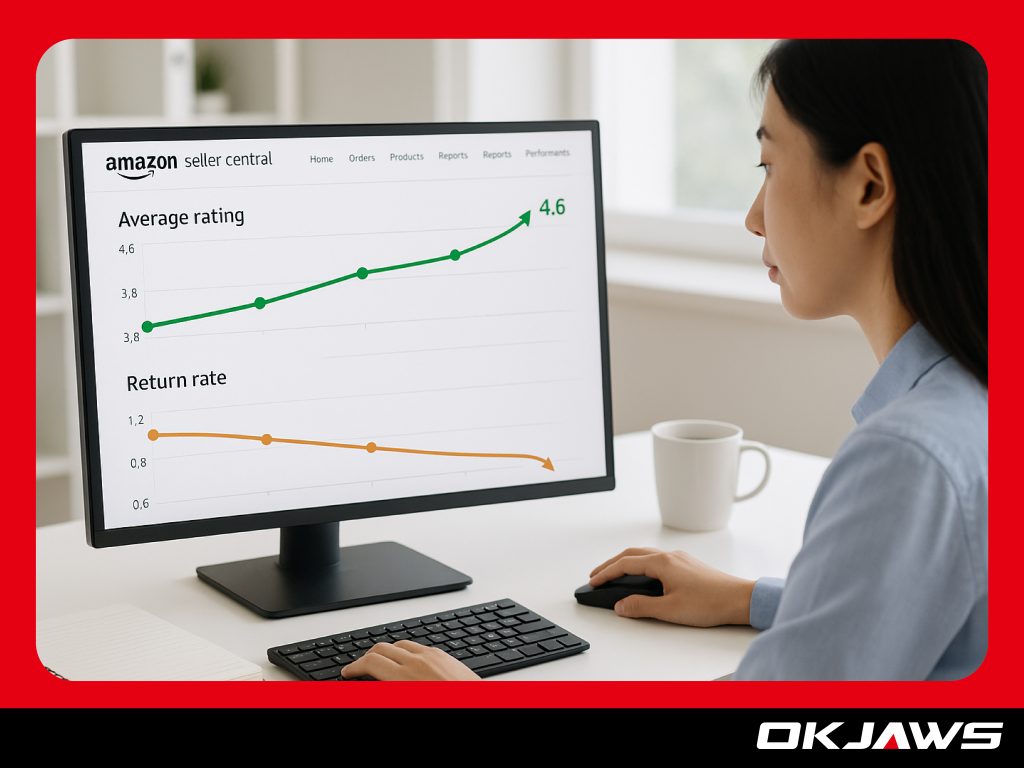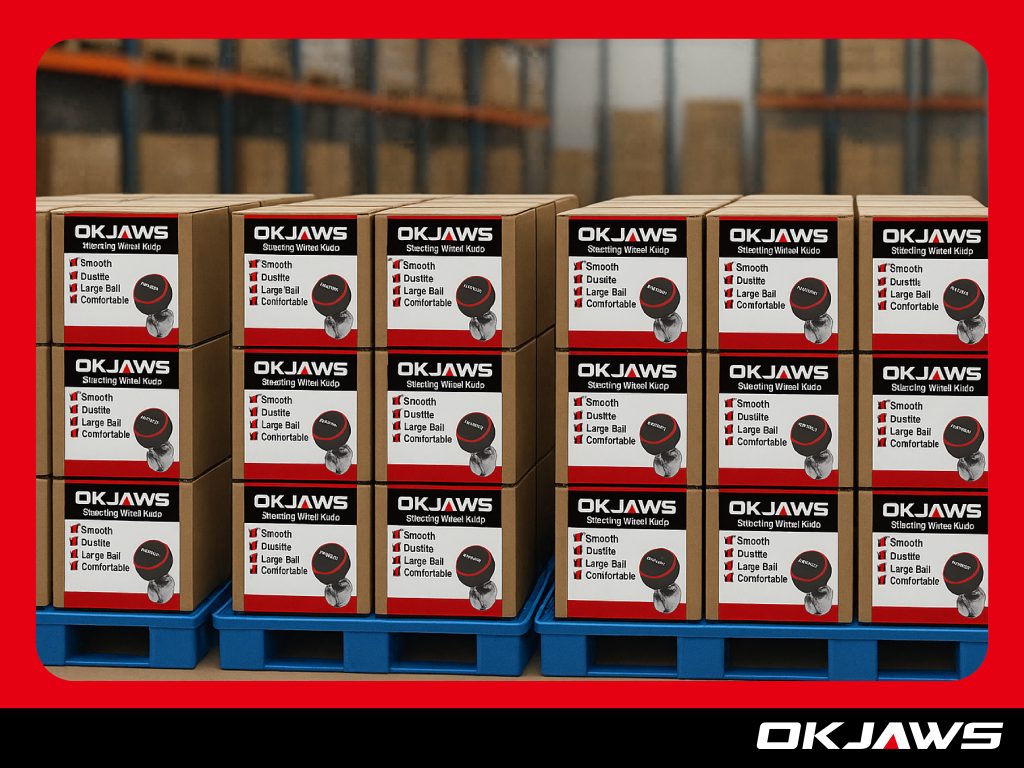Table of Contents
ToggleAbstract
- Product Quality’s Direct Impact – High-quality products earn better Amazon ratings, reduce returns, and improve Buy Box share, while poor quality causes negative reviews and ranking drops.
- Amazon Ranking Factors – Review scores, return rates, and seller performance metrics heavily influence organic visibility and sales.
- Customer Review Dynamics – Positive quality experiences drive 4–5 star ratings and organic review growth; poor quality creates negative social proof and viral complaints.
- Hidden Costs of Poor Quality – Financial losses from refunds, restocking, and unsellable inventory, plus long-term brand trust erosion.
- Measuring Quality – Track return rate, average review rating, Product Defect Rate (PDR), and Voice of the Customer insights using Amazon analytics and third-party tools.
- Improvement Strategies – Pre-launch inspections, post-launch feedback loops, better packaging, and A/B testing to refine product performance.
- Review Optimization – Encourage organic reviews through excellent service, resolve minor issues with compliant follow-up, and maintain quality for compounding rating gains.
- Case Study – A brand improved ratings from 3.8 to 4.6 stars, halved return rates, and increased sales by 28% through targeted quality enhancements.
- B2B Action Plan – Implement structured QA checklists, set inspection schedules, and integrate customer feedback into product development.
- Conclusion – Treat quality as a long-term brand investment by strengthening supplier relationships, prioritizing testing, and pursuing continuous improvement.t.
Introduction: Why Product Quality is the Foundation of Amazon Success
In Amazon’s highly competitive marketplace, product quality isn’t just a selling point—it’s the foundation of sustainable growth. The platform’s algorithm heavily rewards listings that maintain high ratings and low return rates, prioritizing them in search results and increasing their visibility to shoppers. Sellers who consistently deliver superior quality products benefit from stronger organic rankings, better conversion rates, and a higher likelihood of winning the Buy Box—a crucial driver of sales.
The link between quality, customer feedback, and profitability is direct and measurable. High-quality products generate positive experiences, leading to glowing reviews, repeat purchases, and brand loyalty. In contrast, poor quality often results in Amazon returns, negative reviews, and a drop in seller performance metrics, all of which can severely impact your visibility and long-term revenue. Worse yet, a declining review score can erode trust, making even aggressive advertising less effective.
For brands, manufacturers, and private-label sellers, investing in quality control is not an expense—it’s a strategic move toward review optimization, higher profit margins, and long-term success on Amazon.

The Amazon Marketplace Reality: Quality as a Competitive Differentiator
Success on Amazon depends on far more than just competitive pricing or clever keywords. The platform’s search and recommendation algorithm takes multiple performance indicators into account, with review score, return rate, and seller performance metrics among the most influential. A product with consistently high ratings and minimal returns sends Amazon a strong signal that it delivers value to customers—resulting in better search placement, more impressions, and higher click-through rates.
High-quality products create a cycle of growth. When customers receive a product that meets or exceeds expectations, they’re more likely to leave positive reviews, recommend it to others, and return for repeat purchases. This positive feedback loop not only boosts organic ranking but also builds a layer of brand loyalty that can’t be replicated through discounts or advertising alone.
From a B2B perspective, the stakes are even higher. For private-label brands, OEM suppliers, and wholesalers, maintaining impeccable quality directly affects business reputation and account health across multiple sales channels. A consistently high-quality product line enables long-term partnerships, secures bulk orders, and supports sustainable expansion—making quality a decisive competitive advantage in the Amazon marketplace.
How Product Quality Influences Customer Reviews
A positive quality experience is one of the most powerful drivers of Amazon success. When customers receive a product that meets or exceeds their expectations, they are far more likely to leave 4–5 star ratings and write detailed, positive reviews. This leads to steady organic review growth, stronger search rankings, and higher conversion rates—helping the product build long-term momentum without relying solely on paid advertising.
On the other hand, a negative quality experience can quickly undermine a listing’s performance. Poor-quality products tend to generate low-star ratings and trigger negative social proof, discouraging potential buyers before they even reach checkout. In some cases, a single viral complaint—such as an image of a broken item or poorly made packaging—can cause a sudden increase in Amazon returns and lead to lasting damage to the brand’s reputation.
Data supports this direct link between quality and customer feedback. Statista reports that 79% of U.S. online shoppers rank product quality as the most important factor influencing their satisfaction. Amazon’s own performance insights reveal that products with average ratings below 4.0 stars experience sharp drops in both sales velocity and Buy Box share. This proves that even small declines in perceived quality can have an outsized impact on sales performance.
It’s also important to remember that quality perception extends beyond product function. Elements such as sturdy, attractive packaging, easy-to-follow instructions, and a sense of premium value significantly influence how customers rate their experience. Even if the core product works flawlessly, unclear guides or poor presentation can result in avoidable negative reviews. Optimizing these factors not only enhances customer satisfaction but also contributes to review optimization and lower return rates.
Summary: Product quality is a critical driver of Amazon review scores and return rates. Positive experiences lead to 4–5 star ratings, organic review growth, and repeat purchases, while poor quality produces low ratings, negative social proof, and higher returns. Data from Statista and Amazon confirms that quality is the top factor in customer satisfaction, and packaging, instructions, and perceived value play an essential role in maintaining strong reviews and long-term brand trust.

The Hidden Costs of Poor Quality: Returns, Replacements, and Brand Damage
1. Higher Return Rates from Amazon’s Customer-Friendly Policy
Amazon’s easy return policy builds shopper confidence but also amplifies the impact of poor quality. With just a few clicks, dissatisfied customers can send back items for defects, performance issues, or inaccurate descriptions. This convenience increases the return volume for low-quality products, making quality control essential for sellers who want to avoid high refund rates.
2. Financial Impact on Profitability
The costs of poor quality extend well beyond the price of a single returned item. Sellers face lost revenue, restocking fees, and additional handling expenses. Returned products often arrive damaged or unsellable, adding to inventory losses. For FBA sellers, storage, processing, and disposal fees can quickly erode margins—especially when return rates are consistently high.
3. Erosion of Brand Trust and Search Visibility
Quality issues hurt more than sales—they damage your brand reputation. Frequent returns and negative reviews tell both customers and Amazon’s algorithm that a product may be unreliable. The result is a drop in keyword rankings, reduced Buy Box eligibility, and fewer organic impressions. Rebuilding that trust typically requires costly efforts such as heavy advertising, rebranding, or even product redesign.
Summary: Amazon’s easy returns magnify the cost of poor quality, leading to higher refund rates, financial losses from unsellable inventory, and increased operational fees. More critically, it erodes brand trust, damages keyword rankings, and reduces Buy Box visibility, making recovery both expensive and time-consuming.
Measuring & Monitoring Product Quality on Amazon
1. Tracking Key Quality Metrics
Monitoring performance indicators is the first step in maintaining high product standards. Sellers should consistently review:
- Return Rate Percentage – High return rates may indicate recurring product issues, misleading descriptions, or poor packaging.
- Average Review Rating – Ratings below 4.0 can significantly hurt organic ranking and Buy Box eligibility.
- Product Defect Rate (PDR) – Found in Amazon Seller Central, this measures customer-reported defects, which directly impact account health.
- Voice of the Customer Dashboard Insights – Amazon’s tool categorizes customer feedback into “Poor,” “Fair,” and “Good” ratings, helping identify problem areas quickly.
2. Leveraging Amazon’s Built-In Tools
Amazon offers native tools like Brand Analytics and the Voice of the Customer dashboard to help sellers pinpoint and address quality concerns. Brand Analytics provides visibility into top-performing ASINs, conversion rates, and competitive benchmarks, enabling data-driven quality improvements.
3. Using Third-Party Analytics Platforms
Complement Amazon’s data with third-party tools for deeper insights:
- Helium 10 – Tracks review trends, keyword performance, and potential quality-related keyword flags.
- Jungle Scout – Offers competitor analysis, market demand insights, and historical review tracking to benchmark quality against category leaders.
Summary: Sellers can protect product performance by monitoring critical metrics like return rate, review rating, PDR, and Voice of the Customer feedback. Combining Amazon’s built-in analytics with tools like Helium 10 and Jungle Scout enables data-backed quality improvements that reduce returns, boost ratings, and sustain competitive positioning.
Strategies to Improve Product Quality and Reduce Returns
1. Pre-Launch Quality Control
Strong quality management begins before the first sale. Sellers should conduct thorough supplier vetting to ensure manufacturing partners meet required standards. Sample inspections help identify defects early, and lab testing verifies compliance with safety and durability requirements. By addressing potential issues at the pre-launch stage, sellers can prevent costly post-sale problems.
2. Post-Launch Feedback Loop
Once the product is live, maintaining quality requires a continuous feedback loop. Sellers should analyze defect reasons from returns and reviews, then adjust production processes or materials accordingly. Regularly reviewing customer feedback ensures problems are solved quickly, preventing them from becoming widespread.
3. Packaging Improvements
Even the highest-quality products can arrive damaged if packaging is inadequate. Investing in sturdy, protective packaging reduces the risk of transit damage, improves the unboxing experience, and lowers return rates. For fragile or high-value items, adding internal padding, protective seals, or custom inserts can be a worthwhile investment.
4. Continuous Improvement with A/B Testing
Sellers can refine product quality by running A/B tests on product iterations. This could involve testing different materials, design tweaks, or packaging upgrades to see which version generates fewer returns and higher review scores. Gradual, data-driven improvements ensure the product remains competitive and aligned with customer expectations.
Summary: Reducing returns and improving quality requires action at every stage of the product lifecycle—starting with supplier vetting and sample inspections, then using feedback loops to address issues, improving packaging to prevent transit damage, and applying A/B testing to refine product performance. This proactive approach strengthens customer satisfaction, review ratings, and long-term profitability.
Review Optimization Through Quality Enhancement
1. Encouraging Organic Positive Reviews
The most reliable way to boost Amazon ratings is by delivering an excellent customer experience that naturally prompts buyers to leave positive feedback. This means ensuring products arrive on time, in perfect condition, and exactly as described. When customers are delighted with the product’s performance and presentation, they are far more likely to share 4–5 star reviews without any prompting.
2. Using Follow-Up Emails Within Amazon’s TOS
Amazon allows sellers to send permitted follow-up messages to buyers, as long as they comply with the platform’s Terms of Service. These messages can thank the customer for their purchase, provide usage tips, and offer quick support for any issues. Addressing minor concerns—like unclear instructions or missing components—before the customer leaves a review can prevent negative feedback and turn a potentially dissatisfied buyer into a loyal supporter.
3. The Compounding Effect of Consistent Quality
Consistent product quality has a compounding impact on review scores over time. Each positive experience adds to the total number of high ratings, increasing the average score and improving search visibility. This momentum not only attracts more customers but also reinforces brand credibility, making it harder for competitors to displace your product in search rankings.
Summary: Review optimization starts with delivering consistent, high-quality customer experiences. Encouraging organic feedback, proactively resolving minor issues through follow-up emails, and maintaining quality over time create a compounding effect—boosting average ratings, improving visibility, and strengthening brand trust on Amazon.
Case Study: Quality-Driven Amazon Growth
1. Background
A mid-sized private-label home accessory brand selling on Amazon faced stagnating sales due to declining customer satisfaction. The product—an ergonomic office chair—held an average review rating of 3.8 stars, with common complaints about loose screws, poor packaging, and unclear assembly instructions. Return rates hovered at 9%, well above the category average of 4–5%, and organic keyword rankings were slipping from page one to page three for several high-volume search terms.
2. Quality Improvement Actions
The brand initiated a structured quality improvement program that included:
- Supplier collaboration to tighten production tolerances and improve assembly screw quality.
- Pre-shipment inspections to catch defects before items left the factory.
- Packaging upgrades with reinforced corners and clearer assembly diagrams.
- Customer support follow-up to assist buyers before they left negative reviews.
3. Results After Six Months
Within half a year, the changes produced measurable results:
- Average review rating increased from 3.8 to 6 stars.
- Return rates dropped from 9% to 5%, reducing operational costs and inventory losses.
- Organic keyword rankings improved, with the top three targeted keywords returning to page one.
- Sales revenue increased by 28%, driven by higher conversion rates and improved Buy Box share.
Summary: This case study shows how targeted quality improvements—from product refinements to packaging upgrades and proactive customer support—can dramatically boost Amazon performance. The brand’s rating jumped from 3.8 to 4.6 stars, return rates halved, and sales rose 28%, proving that quality-driven strategies deliver both customer satisfaction and measurable business growth.
Action Plan for B2B Sellers and Brands
1. Quality Assurance Checklist for Amazon Product Lines
B2B sellers should establish a clear, repeatable quality control framework to protect product performance on Amazon:
- Vet suppliers for compliance with safety, durability, and industry standards.
- Conduct pre-production sample evaluations to verify quality and functionality.
- Maintain consistent product specifications and tolerances across batches.
- Implement standardized packaging to minimize transit damage.
- Review product listings for accuracy and alignment with the actual product.
2. Recommended Testing Schedules and Inspection Frequency
Proactive testing prevents costly post-sale issues:
- Pre-shipment inspections on every batch to catch defects before reaching customers.
- Quarterly performance reviews to evaluate defect rates, return reasons, and customer feedback trends.
- Annual lab testing for safety compliance and material durability, especially for high-use or safety-sensitive products.
3. Integrating Customer Feedback into Product Development
Customer insights are one of the most valuable tools for product improvement:
- Monitor Amazon review patterns for recurring issues or feature requests.
- Use the Voice of the Customer dashboard to spot early warning signs of quality concerns.
- Collaborate with manufacturing teams to implement changes quickly.
- Track post-improvement metrics to confirm the effectiveness of changes.
Summary: A strong B2B action plan for Amazon success combines supplier vetting, strict testing protocols, and continuous integration of customer feedback into product development. By following a structured checklist, maintaining regular inspections, and acting on consumer insights, sellers can reduce returns, improve ratings, and secure long-term competitiveness on the platform.

Conclusion: Quality as a Long-Term Amazon Strategy
High product quality is more than a production target—it’s the backbone of sustainable Amazon success. Throughout this article, we’ve seen how superior quality directly reduces return rates, boosts customer reviews, and strengthens a product’s position in search rankings. In a competitive marketplace where shoppers can switch to a competitor in seconds, consistent quality is one of the few levers sellers fully control.
For B2B sellers, quality should be viewed not just as a manufacturing process, but as a strategic brand investment. Every dollar spent on better materials, rigorous testing, and effective packaging pays dividends in higher ratings, stronger customer loyalty, and reduced operational costs from fewer returns. The long-term benefits extend beyond Amazon, supporting reputation and trust across all sales channels.
The path forward is clear: invest in supplier relationships, commit to regular product testing, and maintain a culture of continuous improvement. These practices protect account health, ensure customer satisfaction, and position your brand for enduring growth—no matter how competitive the Amazon landscape becomes.
Summary: Quality is the key to reducing returns, increasing reviews, and building brand trust on Amazon. Treat it as a long-term investment by strengthening supplier partnerships, prioritizing testing, and continuously refining products to meet evolving customer expectations.
